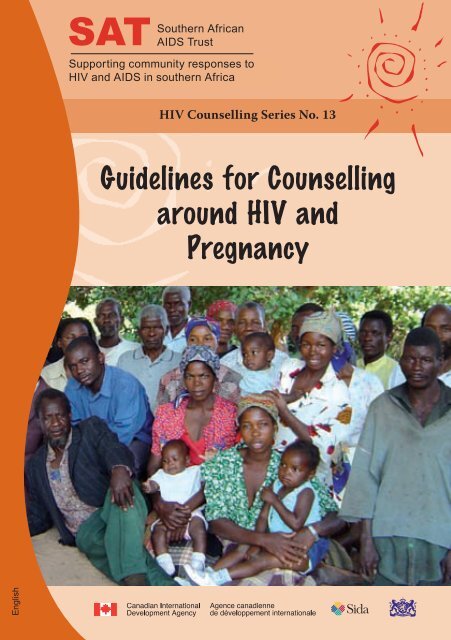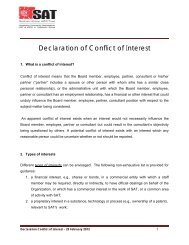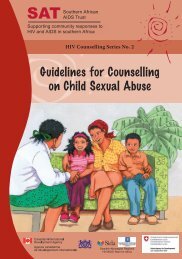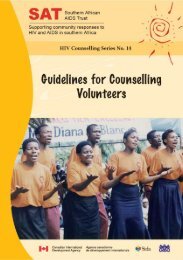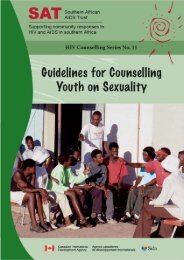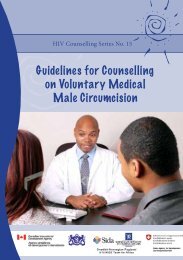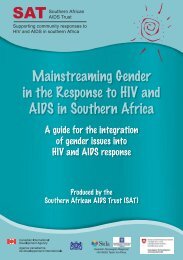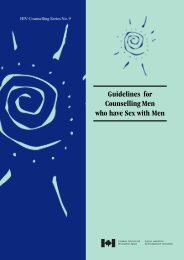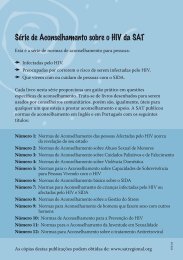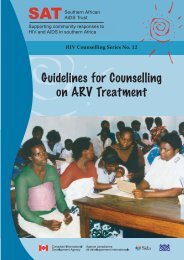Guidelines for Counselling around HIV and Pregnancy - Southern ...
Guidelines for Counselling around HIV and Pregnancy - Southern ...
Guidelines for Counselling around HIV and Pregnancy - Southern ...
- No tags were found...
Create successful ePaper yourself
Turn your PDF publications into a flip-book with our unique Google optimized e-Paper software.
SAT<strong>Southern</strong> AfricanAIDS TrustSupporting community responses to<strong>HIV</strong> <strong>and</strong> AIDS in southern Africa<strong>HIV</strong> <strong>Counselling</strong> Series No. 13<strong>Guidelines</strong> <strong>for</strong> <strong>Counselling</strong><strong>around</strong> <strong>HIV</strong> <strong>and</strong><strong>Pregnancy</strong>English
<strong>Guidelines</strong> <strong>for</strong> <strong>Counselling</strong><strong>around</strong> <strong>HIV</strong> <strong>and</strong> <strong>Pregnancy</strong>
ForewordTh. is.is.the.thirteenth.publication.in.a.series.of.guidelines.<strong>for</strong>.counselling.people.who.are.infected.with.<strong>HIV</strong>,.concerned.about.being.infected.with.<strong>HIV</strong>,.or.are.living.with.or.caring.<strong>for</strong>.people.with.AIDS..Th. is.book.looks.at.specifi.c.issues.<strong>and</strong>.provides.practical.guidance.on.counselling.couples.who.are.infected.with.<strong>HIV</strong>.<strong>and</strong>.who.wish.to.become.(or.who.are).pregnant..Produced.by.SAT.(<strong>Southern</strong>.African.AIDS.Trust).with.the.fi.nancial.support.of.the.government.of.Canada.provided.through.the.Canadian.International.Development.Agency.(CIDA),.the.Swedish.International.Development.Agency.(Sida),.<strong>and</strong>.the.Royal.Netherl<strong>and</strong>s.Embassy.(RNE),.who.do.not.necessarily.share.the.views.expressed.here..First.Edition.May.2007Reprinted.2008<strong>Southern</strong> AfricanSAT AIDS TrustSupporting community responses to<strong>HIV</strong> <strong>and</strong> AIDS in southern Africa©.<strong>Southern</strong>.African.AIDS.TrustExtracts.from.this.publication.may.be.freely.reproduced.with.acknowledgement.of.the.source,.provided.the.parts.reproduced.are.not.distributed.<strong>for</strong>.profi.t.Hard.copies.of.this.publication.may.be.obtained.from:SAT.Regional.Offi..ce.Suite.293,.Dunkeld.West.Centre.281.Jan.Smuts.Ave,.Dunkeld.WestJohannesburg,.South.AfricaTel:.(+27.11).341.0610.Fax:.(+27.11).341.0661Email:.info@satregional.orgYou.can.also.download.the.document.in.PDF.<strong>for</strong>mat.from:.www.satregional.orgDesigned.<strong>and</strong>.published.by.Jacana.MediaTh. e.<strong>Southern</strong>.African.AIDS.Trust.(SAT)*.is.an.independent.regional.organisation..It.has.supported.community.responses.to.<strong>HIV</strong>.<strong>and</strong>.AIDS.in.southern.Africa.since.1991..SAT.is.profoundly.grateful.to.the.volunteers.<strong>and</strong>.professionals.who.have.made.this.<strong>and</strong>.other.publications.possible.Most.of.the.<strong>HIV</strong>.<strong>Counselling</strong>.Series.guidelines.are.the.result.of.workshops.organised.under.SAT’s.School.Without.Walls.(SWW)..Th. is.is.SAT’s.skills-.<strong>and</strong>.lesson-sharing.initiative.that.validates.<strong>and</strong>.promotes.southern.African.experience.<strong>and</strong>.expertise.in.responding.to.<strong>HIV</strong>.<strong>and</strong>.AIDS..SWW.brings.together.professional.counsellors,.people.living.with.<strong>HIV</strong>.<strong>and</strong>.AIDS,.staff..of.AIDS.service.organisations,.<strong>and</strong>.people.working.in.the.fi.eld.addressed.by.the.publications..Counsellors,.practitioners.<strong>and</strong>.people.living.with.<strong>HIV</strong>.from.across.the.region.reviewed.the.book..SAT.would.like.to.acknowledge.the.contribution.of.Gail.Jennings.who.produced.the.fi.nal.draft..SAT.would.also.like.to.thank.Dr.Ishania.Mahabeer,.of.the.Reproductive.Health.<strong>and</strong>.<strong>HIV</strong>.Research.Unit.(RHRU).at.Johannesburg.General.Hospital,.South.Africa,.who.reviewed.the.book;.<strong>and</strong>.Jacana.Media.* SAT was <strong>for</strong>merly known as the <strong>Southern</strong> African AIDS Training Programme.Printed.by.Fishwicks,.Durban.Job.No..000824ISBN:.978-1-920152-06-2
ContentsIntroduction............................................................................................................................................... 2Important Terms.................................................................................................................................. 3Basic <strong>Counselling</strong> Skills <strong>and</strong> Techniques.......................................................... 5Counsellor preparation........................................................................................................... 5What is counselling?.................................................................................................................. 6Skills <strong>and</strong> attitudes needed to be a treatment counsellor............... 7<strong>Counselling</strong> techniques.......................................................................................................... 8Conducting a counselling session............................................................................... 14In<strong>for</strong>mation about <strong>HIV</strong> <strong>and</strong> AIDS <strong>and</strong> PTCT <strong>Counselling</strong>...... 16<strong>Pregnancy</strong>, <strong>HIV</strong> <strong>and</strong> the mother’s health........................................................... 16Why counsel <strong>around</strong> <strong>HIV</strong> <strong>and</strong> pregnancy?..................................................... 17Testing <strong>for</strong> <strong>HIV</strong>................................................................................................................................. 19Why test <strong>for</strong> <strong>HIV</strong> during pregnancy?..................................................................... 19Why test <strong>for</strong> <strong>HIV</strong> be<strong>for</strong>e conception?..................................................................... 22ART <strong>and</strong> conception................................................................................................................... 22Discordant couples....................................................................................................................... 24Termination of pregnancy................................................................................................... 25Prevention of MTCT.................................................................................................................. 26PMTCT during infant feeding........................................................................................ 27Testing a baby <strong>for</strong> <strong>HIV</strong>............................................................................................................. 31Disclosure................................................................................................................................................ 33Where To Go <strong>for</strong> More In<strong>for</strong>mation.......................................................................... 35Notes..................................................................................................................................................................... 36
IntroductionThis book has been written <strong>for</strong> counsellors who are helping women <strong>and</strong>couples who are:thinking about becoming pregnant;thinking about the options of having a baby;already expecting a baby.It is possible that one or both people are <strong>HIV</strong> positive. An <strong>HIV</strong>-positivemother can pass on the virus to her baby even be<strong>for</strong>e it is born, throughblood or body fluids. This can happen:be<strong>for</strong>e childbirth;during childbirth;after childbirth;during breastfeeding.This is known as mother-to-child-transmission (MTCT) or parentto-childtransmission (PTCT). It is possible to help prevent MTCT of<strong>HIV</strong> after becoming pregnant, but it is even better to start taking stepsto prevent transmission be<strong>for</strong>e the baby is conceived. This is why it isimportant <strong>for</strong> counsellors to encourage couples who are thinking abouthaving a baby to test <strong>for</strong> <strong>HIV</strong>.If a client is already pregnant, it is also important to encourage her to test<strong>for</strong> <strong>HIV</strong>. There are many programmes that help to prevent a baby frombeing infected with <strong>HIV</strong> during birth <strong>and</strong> during infant feeding.This book has two sections. The first section reminds counsellorsabout basic counselling skills <strong>and</strong> techniques. The second section givescounsellors basic in<strong>for</strong>mation about <strong>HIV</strong> <strong>and</strong> AIDS, PTCT, <strong>and</strong> testing ababy <strong>for</strong> <strong>HIV</strong>.The book does not give the names <strong>and</strong> details of PMTCT programmes.Different countries use different drugs <strong>for</strong> their programmes <strong>and</strong> mighthave different ways of dealing with issues. As a counsellor, it is important<strong>for</strong> you to find out about the PMTCT programmes in your area, thetypes of infant <strong>HIV</strong> testing done, <strong>and</strong> the laws about termination ofpregnancy. In this way, you can help your clients make in<strong>for</strong>meddecisions.Important TermsThis is a list of words <strong>and</strong> ideas that could be difficult to underst<strong>and</strong>. .It might help to read the list be<strong>for</strong>e beginning the book, <strong>and</strong> think aboutsome of the ideas. The words that are here are bold in the book, so you cancome back to this page if there is something you don’t underst<strong>and</strong>.Adherence counselling: This is helping .clients to take their ARV treatment correctlyevery day.Adopted/Adoption: This means when a childlegally becomes part of a family, with parentswho are not the child’s birth parents.Antenatal clinic: A clinic that looks afterwomen who are pregnant.Antibodies: Part of the blood that fightsillness <strong>and</strong> infection, such as <strong>HIV</strong>. Anantibody test is a blood test that looks <strong>for</strong> .the presence of a particular antibody.ART: ART st<strong>and</strong>s <strong>for</strong> Anti-RetroviralTreatment.ARV drugs: The drugs used in ART are calledAnti-retroviral drugs (ARVs).Artificial insemination: A procedure doneby a health worker or doctor, where a man’ssperm is put inside a woman, without thecouple having unprotected sex.Birth defects: Physical health problems that .a baby is born with.Body fluids: These are liquids made by yourbody, such as blood, semen <strong>and</strong> amniotic fluid.Amniotic fluid is the liquid <strong>around</strong> a baby inthe womb (uterus).Caesarean section: This means giving birthby an operation in a hospital. This is alsocalled a C-section or Caesarean).CD4 count: Is a blood test that shows .how many CD4 cells you have <strong>and</strong> thestrength of the immune system. A healthyperson can have a CD4 cell count of between500 to 1 500 (the number of CD4 cells in amillilitre of blood). When someone has .AIDS, he or she has a CD4 cell count of .200 or less. .Compassionate: This means caring <strong>for</strong>other people.Conceive: To become pregnant. This isalso known as conception.Confidentiality: In<strong>for</strong>mation given to acounsellor by a client is not shared withanyone else, unless the client has given hisor her consent. It is confidential.Disclosure: This is telling people (ordisclosing) your <strong>HIV</strong> status.Discordant couple: A couple .where one partner is <strong>HIV</strong> positive <strong>and</strong> theother partner is <strong>HIV</strong> negative.Discrimination: This is when peopleor groups of people are treated unfairlybecause they are different.Empathy: This is when you canunderst<strong>and</strong> how someone feels,because you can imagine what it islike to be in his or her position.Empowered: When people feelthey are being listened to, <strong>and</strong>they have the strength to dothings <strong>for</strong> themselves.Exclusive breastfeeding:Feeding an infant onlybreastmilk, (no water or otherfoods, only breastmilk <strong>and</strong>medicines prescribed by adoctor).Exclusive <strong>for</strong>mula feeding:Feeding an infant only milk<strong>for</strong>mula.Expressed breastmilk: This meansto squeeze breastmilk out of thebreast by h<strong>and</strong> or with a special typeof pump.
Formula: A dry powder that, when added towater, makes milk used to feed a baby.HAART: This st<strong>and</strong>s <strong>for</strong> Highly ActiveAnti-Retroviral Treatment. This meansthat at least three ARVs are being used<strong>for</strong> treatment.Immune system: Part of the body thatfights infections, diseases <strong>and</strong> viruses.<strong>HIV</strong> <strong>and</strong> AIDS destroy the immunesystem.Infected with <strong>HIV</strong>: This meansthat a person is carrying the HumanImmunodeficiency Virus (<strong>HIV</strong>) inhis or her blood. This person willtest positive <strong>for</strong> <strong>HIV</strong>.In<strong>for</strong>med consent: This means thatthe person who gives permissionunderst<strong>and</strong>s exactly what they areconsenting to.In<strong>for</strong>med decision: Making adecision based on facts <strong>and</strong> correctin<strong>for</strong>mation.Legal guardian: A person who looksafter a child, in the eyes of the law. Thisperson is not always the child’s parent.Mastitis: An infection of the breast ornipple.MTCT: This st<strong>and</strong>s <strong>for</strong> Mother-to-ChildTransmission of the <strong>HIV</strong> virus. This meansthat during birth <strong>and</strong> breastfeeding, amother can sometimes pass <strong>HIV</strong> to her baby.There are ways to stop this transmission,called PMTCT. This st<strong>and</strong>s <strong>for</strong> Prevention ofMother-to-Child Transmission.Natural birth: Giving birth through thevagina.PCR test: PCR st<strong>and</strong>s <strong>for</strong> Polymerase ChainReaction. It is a test used to check <strong>for</strong> <strong>HIV</strong> inblood.Preventive counselling: Giving your .client in<strong>for</strong>mation on how to prevent himor herself from being infected with <strong>HIV</strong>,<strong>and</strong> to practise safe sex.PTCT: This st<strong>and</strong>s <strong>for</strong> Parentto-ChildTransmission of the <strong>HIV</strong>virus. PPTCT st<strong>and</strong>s <strong>for</strong> Preventionof Parent-to-Child Transmission.This means that mothers, fathers <strong>and</strong>caregivers can transmit <strong>HIV</strong>, <strong>and</strong> need totry to prevent transmission.Re-infection: This can happen when aperson living with <strong>HIV</strong> has unsafe sex .(sex without a condom) with another .person living with <strong>HIV</strong>. This means that theperson is infected with <strong>HIV</strong> again. The newinfection could be a resistant strain of <strong>HIV</strong>.Resistant <strong>HIV</strong> is a type of <strong>HIV</strong> that can fightanti-retroviral drugs, stopping these drugsfrom working properly.Safe sex: Intercourse that prevents infectionwith <strong>HIV</strong> <strong>and</strong> other sexually transmittedinfections. One way people can have safe sexis by using a new condom every time theyhave sex.Sperm washing: This is when semen thathas <strong>HIV</strong> in it is washed away from sperm tomake the sperm safe <strong>for</strong> use in artificialinsemination.Stigma: This is judging people negativelybecause you think they are different.Termination of pregnancy: This is anoperation to end a pregnancy. This isalso known as a TOP or an abortion.Ultrasound scan: Using a specialmachine to look at an unborn baby inthe mother’s body.VCT: This st<strong>and</strong>s <strong>for</strong> Voluntary<strong>Counselling</strong> <strong>and</strong> Testing <strong>for</strong> <strong>HIV</strong>.Viral load: This is the number ofcopies of <strong>HIV</strong> in a millilitre of an<strong>HIV</strong>-positive person’s blood. A highviral load means that there is a lot of<strong>HIV</strong> in the blood, destroying the .CD4 cells very quickly.Vulnerable: This is when someone iseasy to hurt or attack, because they arefeeling emotionally weak.Basic <strong>Counselling</strong> Skills<strong>and</strong> TechniquesCounsellor preparation<strong>Counselling</strong> is a structured conversation between two or more people. Theseare a client (or clients) <strong>and</strong> a counsellor. The aim of this conversation is to helpthe client work through a particular problem or situation that he or she faces.This book has been written to help you counsel couples <strong>and</strong> individuals who areplanning to become pregnant, or who have recently discovered that they arepregnant. The couple or individual may or may not yet know their <strong>HIV</strong> status.As a counsellor, you could find yourself in a number of different counsellingsituations, with a number of different counselling goals.Some clients will visit a counsellor <strong>for</strong> preventive counselling. Preventivecounselling means giving your client in<strong>for</strong>mation on how to prevent him .or herself from being infected with <strong>HIV</strong>, <strong>and</strong> to practise safe sex.Other clients might come to you <strong>for</strong> pre-test or post-test counselling. .Pre-test counselling takes place be<strong>for</strong>e your client has an <strong>HIV</strong> test, <strong>and</strong>post-test counselling takes place when you give your client the <strong>HIV</strong> testresult.Supportive counselling means helping your client deal with the manyworries, anxieties <strong>and</strong> challenges he or she may have as a result of livingwith <strong>HIV</strong>.If your client is pregnant <strong>and</strong> taking treatment <strong>for</strong> <strong>HIV</strong> <strong>and</strong> AIDS,she might visit you <strong>for</strong> adherence counselling. Adherence counsellingmeans helping clients to take their treatment correctly every day.For more in<strong>for</strong>mation about different kinds of <strong>HIV</strong> counselling, youcan read SAT’s <strong>HIV</strong> <strong>Counselling</strong> Series 6: Basic AIDS <strong>Counselling</strong><strong>Guidelines</strong>.The aim of counselling is to help someone work through a problem on hisor her own.
What is counselling?<strong>Counselling</strong> IS:listening actively to a client;giving a client space to talk about his or her problem;helping a client underst<strong>and</strong> his or her problem;giving a client correct <strong>and</strong> appropriate in<strong>for</strong>mation;helping a client make an in<strong>for</strong>med decision;helping a client to underst<strong>and</strong> the results of that decision;helping a client recognise <strong>and</strong> build on his or her own strengths.<strong>Counselling</strong> IS NOT:telling a client what to do;making decisions <strong>for</strong> a client;judging a client <strong>for</strong> his or her behaviour or cultural <strong>and</strong> .religious beliefs;blaming a client;arguing with a client;telling a client what you would do if you were him or her;making a client depend on you <strong>for</strong> advice <strong>and</strong> solutions.<strong>Counselling</strong> is helping a person find the solution to his or her ownproblem. It is not telling someone what you would do in his or hersituation.Skills <strong>and</strong> attitudes needed to be a treatmentcounsellorTo be an effective counsellor you need to:show respect <strong>for</strong> your client <strong>and</strong> other people;take responsibility <strong>for</strong> what you do or say to your client;listen actively;know your limits as a counsellor;be honest <strong>and</strong> trustworthy;not judge anyone;be patient <strong>and</strong> compassionate;be able to leave your own worries behind, <strong>and</strong> focus on your client;be empathetic.You also need to know your own cultural, personal or religious beliefs <strong>around</strong><strong>HIV</strong> <strong>and</strong> pregnancy. You need to think about how these beliefs might affectyour opinion. Some people might believe that it is a woman’s duty to havechildren; others might believe it is a woman’s choice to have children. Somepeople might believe that termination of pregnancy is wrong, <strong>and</strong> otherpeople might think that giving birth by Caesarean section is wrong.To be an effective counsellor you also need to be knowledgeable about <strong>HIV</strong><strong>and</strong> AIDS, <strong>and</strong> pregnancy. You also need to know when to refer your clientto someone else. Referring a client means giving him or her the contactdetails of another counsellor, health worker or helper. This person maybe able to help more effectively than you can.The second part of this book will give you some important in<strong>for</strong>mationabout pregnancy <strong>and</strong> the prevention of parent-to-child transmission(PPTCT). You need to have the correct in<strong>for</strong>mation to be able to guideyour clients to make a decision.RememberMedical science is always making new discoveries <strong>and</strong> inventing newtests, producing new drugs <strong>and</strong> finding out more about PPTCT. As acounsellor you must read <strong>and</strong> research as much as you can, to find outthe latest in<strong>for</strong>mation. This will mean you are always up to date, <strong>and</strong>can give your clients accurate in<strong>for</strong>mation. You also need to look afteryour own health <strong>and</strong> emotions, so that you have enough strength <strong>and</strong>energy to care about your clients.
<strong>Counselling</strong> techniquesYou will find more details about counselling techniques in SAT’s<strong>HIV</strong> <strong>Counselling</strong> Series 6: Basic AIDS <strong>Counselling</strong> <strong>Guidelines</strong>.Here is a summary of the most important techniques.ConfidentialityEverything that your client tells you is confidential, unless you have hisor her in<strong>for</strong>med consent to tell someone else. You should not even tellanyone else that someone is your client.Why confidentiality is importantThe aim of counselling is to help your client think carefully about his orher problems. This can only happen if they are honest with themselves<strong>and</strong> with you. Your client is more likely to be honest with you if he orshe knows you will keep everything confidential.There is a lot of stigma <strong>and</strong> discrimination <strong>around</strong> <strong>HIV</strong> <strong>and</strong> AIDS. .You need to help protect your client from this.Active listeningActive listening means that you listen very carefully to what your clientis telling you. You do not listen with one ear while your mind is thinkingabout what to say next (or about what to prepare <strong>for</strong> dinner after thesession!).Active listening also means showing your client that you are listening.Look at your client while he or she is talking. Remember that in somecultures it is rude to look at another person in the eye.Put away any distractions. This could be a cell phone, a radio, a s<strong>and</strong>wich<strong>and</strong> so on.Use your body language properly. You can do this by sitting in a relaxedway, not playing with your hair or clothes, <strong>and</strong> by nodding your head orsaying ‘mmm’ or ‘aha’ to show you are listening.Keep your posture open – do not fold your arms over your body.Ask questions.Repeat what your client has said to you in a different way. This shows thatyou have understood his or her feelings.Practise active listening with your friends <strong>and</strong> family.
Asking questionsWhen you ask questions, you <strong>and</strong> your client can explore the problem.Try to ask simple questions.Ask one question at a time <strong>and</strong> wait <strong>for</strong> the answer.Try to ask open-ended questions. These are questions that do nothave a quick answer like ‘yes’ or ‘no’.Open-ended questions often start with words like ‘tell’, ‘how’ or ‘what’.‘Tell me more about…?’‘How do you feel about…?’‘What would happen if…?’The client will then think about their answer <strong>and</strong> apply it to their problem.Closed questions often start with words like ‘who’, ‘when’ or ‘do’.7Are you going totry to becomepregnant?Yes!Showing empathyShowing empathy means underst<strong>and</strong>ing the feelings your client has about hisor her problem. You do not have to feel the same feelings.You do not have to have children of your own to show empathy <strong>for</strong> someonewho is thinking about becoming pregnant, or is pregnant.When you show empathy, try to give your client’s feelings a name. Saysomething like ‘You sound as if you are feeling sad’, or ‘It sounds like youare feeling guilty’. Don’t worry if you say the wrong thing – your clientwill correct you, <strong>and</strong> this will help him or her to think deeply about thosefeelings.How do you feelabout trying tobecome pregnant?Well, I have manyworries about it,but I have alwayswanted to have atleast one baby…Think about all the different feelings people can have. Sometimeswe can get stuck talking only about feeling sick or well, happy orunhappy.Empathy is not the same as sympathy, pity or feeling sorry <strong>for</strong>someone. When you feel sorry <strong>for</strong> someone, you can make him or herfeel weak or helpless. A counsellor’s aim is to help a client feel strong4<strong>and</strong> empowered.10 11
Building your client’s strengthsYour role as a counsellor is to help a client find his or her own solutionsto a problem. The client probably already has ways of finding a solution,but might not realise this.You also have another role: to help a client find his or her innerstrengths. Your client might have <strong>for</strong>gotten his or her own strengths.Identify what he or she has already done to overcome a problem ordifficulty.Find out what solutions worked <strong>and</strong> what solutions did not.Help the client underst<strong>and</strong> why the problem solving did or did notwork.Identify a personal goal with your client <strong>and</strong> work out a plan toachieve it.SummarisingSometimes it is useful to briefly repeat or summarise what your clienthas said. You can do this:to make sure you have understood what he or she is saying;to remind each other what you talked about in the last session;to move on to a new subject;to end a counselling session.Role-playing or actingYour client may find it helpful to practise how to deal with a situation, such asdisclosing his or her <strong>HIV</strong> status. Acting out a conversation or situation withyour client is called role-playing.Have you sharedthe problemwith anyone?I have talked to my sister,<strong>and</strong> she reminded me thatI have made many gooddecisions in my life.I must believe in myself.Some useful questions to find out a client’s inner strength.What have you done about this problem?Have you shared the problem with anyone else? Who was this .person?Are there things you could have done differently?12 13
Conducting a counselling sessionBe<strong>for</strong>e a sessionTry to put your own worries <strong>and</strong> problems behind you.Know how much time you can spend with your client.Tell people they must not interrupt you.Have some paper <strong>and</strong> a pen ready to take notes. Check any previousnotes you might have.Have support materials ready. These could be leaflets on pregnancy<strong>and</strong> labour.Beginning a sessionAlways smile <strong>and</strong> welcome your client.Tell him or her how long you can spend together.If this is the first time your client has visited you, tell him or her whatyou do as a counsellor. Remind the client that your role is not to solveproblems, but to help him or her to find their own solutions.Remind the client that everything in the session is confidential.Do not sit too close to your client – or too far away.Listen actively <strong>and</strong> use all your counselling skills <strong>and</strong> techniques.Ending a sessionSummarise what has been discussed. Talk about what they havedecided to do, <strong>and</strong> agree on what to do next.Ask your client if he or she has any questions. These could be aboutdifferent types of drugs or ways to eat properly.Set a time <strong>for</strong> another meeting, if you think it is needed.Smile <strong>and</strong> be friendly as you walk with your client to the door.RememberDo not see another client immediately afterwards. Give yourself time tothink about the session you just had. Is there anything you wish you hadsaid? Is there anything you wish you had not said? Try to learn from eachsession, so you can get better at helping clients. Then give yourself sometime to prepare <strong>for</strong> the next client.Can we make anappointment <strong>for</strong>this afternoon?I am busy preparing<strong>for</strong> my next client.During a sessionDiscuss the reasons <strong>for</strong> the visit.Help your client identify a problem or difficulty. If he or she has .more than one problem, decide together which is the most important<strong>for</strong> that day.Always have correct in<strong>for</strong>mation to give your client. This will helpyour client to make an in<strong>for</strong>med decision.Help him or her explore options <strong>and</strong> solutions.Support him or her in making choices <strong>and</strong> taking decisions. Discusswhat things could happen with each choice.Help your client find a way to cope with the problem or difficulty.14 15
In<strong>for</strong>mation about <strong>HIV</strong> <strong>and</strong>AIDS <strong>and</strong> PTCT <strong>Counselling</strong>This section will give you more in<strong>for</strong>mation on <strong>HIV</strong> <strong>and</strong> AIDS, <strong>and</strong> howparent-to-child transmission (PTCT) happens. It will also help you withspecific problems that clients wanting to fall pregnant might have, <strong>and</strong>how to counsel <strong>around</strong> these issues.MTCT st<strong>and</strong>s <strong>for</strong> Mother-to-Child Transmission. When an <strong>HIV</strong>-positivewoman is pregnant, there are things that can be done to help reduce therisk of giving <strong>HIV</strong> to the unborn child. Not all women who are infectedwith <strong>HIV</strong> give birth to babies with <strong>HIV</strong>. PMTCT st<strong>and</strong>s <strong>for</strong> Prevention .of Mother-to-Child Transmission.PTCT st<strong>and</strong>s <strong>for</strong> Parent-to-Child Transmission. This is different fromMTCT because it is not only mothers who can transmit <strong>HIV</strong> to children,but also fathers <strong>and</strong> other caregivers. PPTCT st<strong>and</strong>s <strong>for</strong> Prevention ofParent-to-Child Transmission.<strong>Pregnancy</strong>, <strong>HIV</strong> <strong>and</strong> the mother’s healthHealth workers used to tell <strong>HIV</strong>-positive women that pregnancy wouldmake them weak <strong>and</strong> vulnerable. They also said that their pregnancycould cause their infection to progress to AIDS more quickly.Today, researchers <strong>and</strong> doctors have found that there is no proof <strong>for</strong> thisbelief. However, it is still important <strong>for</strong> a woman who is pregnant:to try to live as healthily as possible;to visit her antenatal clinic regularly;to try to eat healthy foods;to exercise lightly;to practise safe sex, in order to avoid re-infection;to stop smoking;to avoid alcohol.This will give both the mother <strong>and</strong> the baby the best chance of being healthy.As a counsellor, help your client find ways of living a healthy lifestyle,to give her <strong>and</strong> her baby the best chance of good health.Why counsel <strong>around</strong> <strong>HIV</strong> <strong>and</strong> pregnancy?A counsellor can help clients cope with the emotions <strong>and</strong> challenges they .face when they want to become pregnant. This could be:concern about what pregnancy will do to their health;worrying what people will say about an <strong>HIV</strong>-positive person having .a baby;fear of infecting their <strong>HIV</strong>-negative partner;fear of not living long enough to see their baby become an adult;concern about infecting the unborn baby;confusion about anti-retroviral treatment, <strong>and</strong> how it can help PPTCT;worry about not being able to care <strong>for</strong> a baby born with <strong>HIV</strong>.Many people will also be fearful that choices <strong>around</strong> PPTCT will <strong>for</strong>ce themto disclose their own <strong>HIV</strong> status. This could happen if a couple choosesto <strong>for</strong>mula-feed their baby. They might then have to explain this choice toother people.As a counsellor, it is important to do the following things.Help clients think about why they want to become pregnant.Help clients make in<strong>for</strong>med decisions about becoming pregnant.Assist clients to make in<strong>for</strong>med decisions about PPTCT duringpregnancy, childbirth <strong>and</strong> infant feeding.Let clients develop problem-solving <strong>and</strong> coping skills.Help clients to make choices <strong>and</strong> decisions about disclosure.Let clients find a lifestyle that allows them to take care ofthemselves <strong>and</strong> their baby.16 17
As a counsellor, it is important to do the following things.Give your client correct in<strong>for</strong>mation about the risks <strong>and</strong>consequences of having a child, if the mother is <strong>HIV</strong> positive.Counsel couples about what it means to have a child. Always acceptyour clients’ values, attitudes <strong>and</strong> beliefs about children, even if theyare different from your own beliefs.REMEMBERUnderst<strong>and</strong> that some couples would rather not know their <strong>HIV</strong>status. Listen to their fears about <strong>HIV</strong> <strong>and</strong> AIDS. Help them tounderst<strong>and</strong> the advantages, <strong>for</strong> themselves <strong>and</strong> their baby, ofknowing their status.Refer clients <strong>for</strong> testing, if they wish to know their status. Theywill then be able to take steps to prevent transmission to theirbaby. You can read more about this on pages 26-28.Give your clients correct in<strong>for</strong>mation about treatment <strong>and</strong>management of <strong>HIV</strong> <strong>and</strong> AIDS. Some of your clients’ fears mightbe because they do not have good in<strong>for</strong>mation. Many peoplebelieve that they will get very sick <strong>and</strong> die quickly if they have <strong>HIV</strong>.Some couples would rather not disclose their status to health workers attheir antenatal clinic, because of fear of discrimination. Listen to theirfears, <strong>and</strong> give in<strong>for</strong>mation about support groups in their area.Testing <strong>for</strong> <strong>HIV</strong>It is important <strong>for</strong> anyone to know their <strong>HIV</strong> status. It does not matter ifthey want to fall pregnant or not, they should still find out their status.If someone tests negative <strong>for</strong> <strong>HIV</strong>, he or she must try to stay <strong>HIV</strong> negative.If someone tests positive <strong>for</strong> <strong>HIV</strong>, he or she can then:Practise safe sex, so that other people are protected from infection.The person can then protect him or herself from re-infection.Do everything possible to live a healthy life.Take the correct treatment <strong>for</strong> <strong>HIV</strong> <strong>and</strong> AIDS. This is called ART, .or anti-retroviral treatment.The sooner someone living with <strong>HIV</strong> <strong>and</strong> AIDS starts living positively, .<strong>and</strong> takes the correct treatment <strong>for</strong> <strong>HIV</strong> <strong>and</strong> AIDS, the better his or herchance of living a long, healthy life.Why test <strong>for</strong> <strong>HIV</strong> during pregnancy?An <strong>HIV</strong>-positive mother can pass the virus to her baby even be<strong>for</strong>e it .is born. Remember that <strong>HIV</strong> is transmitted between adults through .body fluids, such as semen or blood. <strong>HIV</strong> is transmitted in the same .way between a mother <strong>and</strong> her baby, through body fluids <strong>and</strong> blood.Mother-to-Child TransmissionBe<strong>for</strong>e childbirth<strong>HIV</strong> is passed from the mother to her unborn baby while the baby isstill growing inside her womb (uterus). This is because the mother’sblood can sometimes mix with the baby’s blood while the baby is stillin the womb.During childbirthThe baby can be infected through close contact with the mother’s .body fluids during childbirth.After childbirthThis normally happens during breastfeeding, when the baby drinks themother’s breastmilk.18 19
If a baby or child does test positive <strong>for</strong> <strong>HIV</strong>, he or she needs to be takento a doctor as soon as possible. The child can still live a healthy life <strong>for</strong>many years, because there are special ARTs <strong>for</strong> children.If an <strong>HIV</strong>-positive mother does not take prevention of mother-to-childtransmission measures, there is a chance that her baby will be bornwith <strong>HIV</strong>. 40 out of every 100 babies born to <strong>HIV</strong>-positive mothers areborn with <strong>HIV</strong>.With PMTCT measures, however, only 15 out of every 100 babiesborn to <strong>HIV</strong>-positive mothers will be born <strong>HIV</strong> positive.REMEMBERTaking PMTCT measures does not stop all transmission of <strong>HIV</strong>.As a counsellor, you must in<strong>for</strong>m your client of this. It is the client’sdecision whether or not to have a child, but your role as a counsellor isto help them make this decision knowing the risks <strong>and</strong> consequencesof having a child.Testimony 1: The choiceto have a baby is ours“My husb<strong>and</strong>, Madalo, <strong>and</strong> I had been married <strong>for</strong>three years when we decided to have a baby. Verysoon I fell pregnant, <strong>and</strong> we had a baby girl. We werevery sad when she died at 2 years old. She was alwayssick with something or other.I visited a counsellor to help me with my grief. My counsellor said it might bea good thing to go <strong>for</strong> VCT. I was afraid, but with my counsellor’s support I hadan <strong>HIV</strong> test. It came back positive.I put together all my courage, <strong>and</strong> told Madalo. We both visited the counsellor,<strong>and</strong> Madalo took an <strong>HIV</strong> test. It was also positive. Not too long after this, myhusb<strong>and</strong>’s parents started to ask questions about us having another child. “Youare not doing the right thing”, they said. “Maybe you are not a good wife to ourson,” they said.Madalo <strong>and</strong> I talked again to our counsellor who told us about somethingcalled PMTCT, that helps to stop the new baby getting <strong>HIV</strong>. But when wespoke about it, we both agreed that we could not have another heartbreak.It was hard <strong>for</strong> us, because of our traditions, but we decided that having ababy is our choice, not our parents.Today we do have a child! She is a beautiful girl, <strong>and</strong> she is four years old.We adopted her from an organisation near our home, <strong>and</strong> we are allhappy. We know this was the right thing <strong>for</strong> us to do.”Madalo <strong>and</strong> Zaida, proud parents20 21
Why test <strong>for</strong> <strong>HIV</strong> be<strong>for</strong>e conception?It is possible to help prevent MTCT of <strong>HIV</strong> after becoming pregnant,but it is even better to start taking steps to prevent MTCT be<strong>for</strong>econception. With careful planning, a woman can reduce the amount of<strong>HIV</strong> in her blood (her viral load) be<strong>for</strong>e she conceives. This will reducethe chances of MTCT.It is <strong>for</strong> this reason that it is important <strong>for</strong> couples to test <strong>for</strong> <strong>HIV</strong>be<strong>for</strong>e pregnancy. In this way, they will be able to give their baby thebest possible chance of being healthy.If your client tests positive <strong>for</strong> <strong>HIV</strong> <strong>and</strong> wants to have a baby, suggestthat she has more tests to find out her CD4 count <strong>and</strong> her viral load.If her viral load is low, there is less chance of MTCT. If her viral loadis high, her health worker might suggest that she begin taking ART.After a few months, the ART will bring down her viral load.ART <strong>and</strong> conceptionIf your client is already taking HAART, ask her which ARVs she istaking. Some ARVs can be dangerous <strong>for</strong> unborn babies, <strong>and</strong> theycan cause birth defects. Suggest that your client visits her doctorimmediately, so that she can take different ARVs that are not dangerous<strong>for</strong> her baby. If your client is already pregnant <strong>and</strong> taking ARVs, sheshould see her doctor as soon as possible to find out if the type of ARVshe is taking is safe <strong>for</strong> the baby.Try to learn the names of the ARV medicines prescribed in your area.Find out which ones are safe <strong>for</strong> pregnant women, <strong>and</strong> which ones aredangerous. Some ARVs are dangerous <strong>for</strong> men <strong>and</strong> women who want tohave children.Testimony 2:Speak to your doctor“I have always wanted at least one child of my .own – <strong>and</strong> today, after being <strong>HIV</strong> positive <strong>for</strong> 13years, I have a beautiful, healthy boy. Let me tell youhow this happened.I am now 30 years old, but I tested <strong>HIV</strong> positive when I was 17. I first thoughtthat I was going to die. Then I thought that even if I lived <strong>for</strong> a few years, Iwould be too sick to have a baby.But about five years ago I started taking ARTs, <strong>and</strong> soon I was so much betterthat I decided the time was right to have a baby. I was still afraid, though. Ithought that my doctor would criticise me, <strong>and</strong> refuse to treat me. I used tovisit her every month, but I stopped seeing her while I was trying to becomepregnant.My adherence counsellor helped me to realise that if I wanted the best <strong>for</strong>my own health <strong>and</strong> that of my planned baby, I should talk to the person whowas caring <strong>for</strong> my health – my doctor! Eventually I went to visit her, <strong>and</strong> toldher my plans. Instead of her being angry with me, she was excited that I wasfeeling so positive about my future. And more importantly, she explainedto me that one of the ARV medicines I was taking would damage mybaby! I am so glad I spoke to her.She changed my treatment, <strong>and</strong> a few months later I conceived myboy. Because I was open about my <strong>HIV</strong> status, I was not afraid to ask<strong>for</strong> birth by the Caesar operation. I chose to feed my baby with milk<strong>for</strong>mula. It is lucky that I live in a city with clean water from a tap. .My boy is <strong>HIV</strong> negative, <strong>and</strong> I am still healthy <strong>and</strong> well.”Josina, 30 years old22For example, if a woman conceives while taking Efavirenz, a type of ARV,there is a chance that her baby will be abnormal. An ultrasound scanwill show the mother <strong>and</strong> the health workers if the baby is normal orabnormal. As a counsellor, you will need to counsel the mother <strong>around</strong>the possibility of an abnormal child, the challenges that may arrive,<strong>and</strong> her right to choose a termination. Encourage your client to checkwith her health worker which ARVs can cause abnormalities in unbornchildren.23
Discordant couplesA discordant couple is a couple where one partner is <strong>HIV</strong> positive <strong>and</strong>the other partner is <strong>HIV</strong> negative.If a discordant couple wants to have a baby together, they will need tohave sex without a condom. There is a chance that the <strong>HIV</strong>-positivepartner will infect the <strong>HIV</strong>-negative partner. However, this need nothappen. Discordant couples can choose artificial insemination or .sperm washing.Some hospitals, clinics <strong>and</strong> private doctors offer a service called artificialinsemination to help couples have babies. When the woman is <strong>HIV</strong>positive <strong>and</strong> her partner is <strong>HIV</strong> negative, artificial insemination meansthat the doctor takes the man’s sperm <strong>and</strong> puts it inside the woman,without the couple having unprotected sex. The man is there<strong>for</strong>eprotected from <strong>HIV</strong> infection from his partner.If the woman is <strong>HIV</strong> negative <strong>and</strong> the man is <strong>HIV</strong> positive, some privatehospitals offer sperm washing followed by artificial insemination. Washingthe sperm removes all the <strong>HIV</strong> found in the fluid <strong>around</strong> the sperm.There<strong>for</strong>e only sperm, <strong>and</strong> not <strong>HIV</strong>-infected cells, are used in artificialinsemination.Discordant couples can .maintain a happy <strong>and</strong> .healthy relationship.As a counsellor, you could keep a list of clinics <strong>and</strong> hospitals in yourarea that offer artificial insemination <strong>and</strong> sperm-washing services.Termination of pregnancySome <strong>HIV</strong>-positive women or couples have unplanned pregnancies, <strong>and</strong>they might feel it would be better <strong>for</strong> them not to have the baby. Theymight not want to take the chance of the baby being infected with <strong>HIV</strong>, <strong>and</strong>worry that they will not be able to take care of a sick child because of theirown <strong>HIV</strong> infection. They may also be worried that they will be too sick tolook after a child, or that they may die.Termination of pregnancy (also known as a TOP or an abortion) islegal in many countries in southern Africa. Many government clinicsoffer termination of pregnancy <strong>for</strong> free. The least risky time to terminate apregnancy is in the first three months (12 weeks) of pregnancy.As a counsellor, is it important to do the following things.Help your client underst<strong>and</strong> why she does not want to continue with herpregnancy. Some of her fears about <strong>HIV</strong> <strong>and</strong> pregnancy might be becauseof a lack of in<strong>for</strong>mation.Give the couple accurate in<strong>for</strong>mation about:– the risks of parent-to-child transmission of <strong>HIV</strong>;– ways of trying to prevent parent-to-child transmission of <strong>HIV</strong>;– positive living, so that she <strong>and</strong> her partner can stay healthy <strong>for</strong> along time.Know your country’s laws about termination of pregnancy.Have a list of clinics <strong>and</strong> health workers who will be able tohelp your client, if she <strong>and</strong> her partner decide to terminate thepregnancy.Help the couple make an in<strong>for</strong>med decision about continuing(carrying on) or discontinuing (not carrying on) the pregnancy.Do not judge them <strong>for</strong> their decision.Remember that in many cultures, women are expected to havechildren. There is a stigma to being childless, or terminatinga pregnancy. Many women may wish to keep their decision toterminate a secret. This might be because they fear violence fromtheir partner, or anger from their community. Remind your clientthat you will keep her story confidential.In<strong>for</strong>m your client about other choices, like adoption <strong>and</strong> foster care.24 25
Prevention of MTCTPMTCT during pregnancyIf a mother, who is not already taking ARVs, wants a natural birth she needsto take ARVs at some point be<strong>for</strong>e or during her labour. Exactly when shehas to take them depends on the kind of drugs available at the health clinic.Some are taken four weeks be<strong>for</strong>e labour, others are only taken duringlabour. Read more about ARVs during pregnancy on page 22.PMTCT during childbirthPMTCT programmes help to prevent a baby from being infected with <strong>HIV</strong>during the birth process. MTCT can be reduced if:an <strong>HIV</strong>-positive mother gives birth by planned operation, such as a .C-section or Caesarean. This means that the baby will not come intoas much contact with the mother’s body fluids during birth. .The chance of infection is then reduced;a mother who wants a natural birth takes ARVs be<strong>for</strong>e or duringlabour, depending on the ARVs available;the baby is given a short course of ARVs once it is born.For more in<strong>for</strong>mation on ARV treatment, read SAT’s <strong>HIV</strong> <strong>Counselling</strong>Series No. 12: <strong>Guidelines</strong> <strong>for</strong> <strong>Counselling</strong> on ARV Treatment.PMTCT during infant feedingBreastfeeding gives a newborn baby the best possible nutrition. It alsoboosts the infant’s immune system, <strong>and</strong> reduces the risk of the baby gettingdiarrhoea. Diarrhoea is a cause of many deaths among infants in southernAfrica. However, there is a risk that an <strong>HIV</strong>-positive mother might transmit<strong>HIV</strong> to her baby through breastfeeding.Health workers have different thoughts about whether or not an <strong>HIV</strong>-positivemother should breastfeed. This is what the World Health Organizationrecommends:It is essential that mothers decide on ONE WAY ONLY of feeding their baby:either breastfeeding ONLY; or milk <strong>for</strong>mula ONLY. Mixed feeding, which is acombination of breastmilk, <strong>for</strong>mula <strong>and</strong> food, gives the baby the biggest chanceof getting <strong>HIV</strong> from the mother.As a counsellor, it is important to do the following things.Provide accurate, helpful in<strong>for</strong>mation. This will help your client makein<strong>for</strong>med decisions about PMTCT. Make a list of the hospitals, clinics orNGOs in your area that offer PMTCT programmes.Remind your clients that even with a good PMTCT programme, thereis still a chance that the baby will be born <strong>HIV</strong> positive. Help the couplethink about the possibility of having a baby with <strong>HIV</strong>.Underst<strong>and</strong> that your client may not wish to disclose her <strong>HIV</strong> status toher health workers. She will then not be able to participate in the PMTCTprogramme. Do not judge your client, but help her to think carefullyabout her choices.Prepare your client <strong>for</strong> the possibility that she might have to start takinglong-term ART after she has given birth. She might be worried aboutARTs, because she may think they are dangerous. Find out as muchas you can about the ART medicines <strong>and</strong> programme at the clinics inyour area, so that you are able to provide accurate in<strong>for</strong>mation. Thismeans taking the right drugs at the right time, every day.Exclusive breastfeeding means giving the baby breastmilk only, untilthe baby is six months old. This means no water, cow’s milk, infant<strong>for</strong>mula or other food. The baby must only be given breastmilk, <strong>and</strong>medicine given by a doctor or nurse. Anything else will upset thebaby’s stomach, <strong>and</strong> make it easier <strong>for</strong> <strong>HIV</strong> to get into his or her body.Exclusive breastfeeding is recommended <strong>for</strong> women:who cannot af<strong>for</strong>d to buy <strong>for</strong>mula. In some countries, <strong>for</strong>mulais sometimes provided free <strong>for</strong> six months – find out what yourcountry provides;who do not have access to clean tap water;who are afraid of the stigma if they feed using <strong>for</strong>mula.26 27
A woman who chooses to breastfeed should have a low viral load <strong>and</strong> ahigh CD4 count. In other words, she should not have AIDS.If a mother who is practising exclusive breastfeeding gets mastitis (aninfection of the breast <strong>and</strong> nipples), she must not stop breastfeeding.She must NOT give mixed food to her baby. Health workers suggestthat she feeds from the uninfected breast, <strong>and</strong> expresses the milkfrom her infected breast. She must throw away this infected milk.Exclusive <strong>for</strong>mula feeding means giving the baby only milk <strong>for</strong>mulafrom birth, <strong>for</strong> six months.Exclusive <strong>for</strong>mula feeding is recommended <strong>for</strong> women:who have easy access to very clean water. Dirty water could putthe child at risk of infection <strong>and</strong> diarrhoea;who have access to free or cheap milk <strong>for</strong>mula;who will always be able to get milk <strong>for</strong>mula, <strong>and</strong> will never have .to breastfeed.Testimony 3:The neighbours willstart to talk…“My girlfriend, Nteseng, <strong>and</strong> I are <strong>HIV</strong> positive,but we have not told anyone about this yet. We have anew baby – she is only two weeks old. In our cultureit is expected that my girlfriend breastfeeds our baby. Our counsellor hasexplained to us that our baby might become infected with <strong>HIV</strong> if Ntesengbreastfeeds her.The problem <strong>for</strong> me is that if we choose the <strong>for</strong>mula, my family <strong>and</strong> theneighbours will start to talk. In our community, we think that the mothers whouse <strong>for</strong>mula are <strong>HIV</strong> positive. So, what must we do?Our counsellor helped us to see that we must do what is best, <strong>and</strong> safe, <strong>for</strong>Nteseng <strong>and</strong> our baby. I am not ready to disclose, so I don’t want to use<strong>for</strong>mula. I also don’t want the virus to be transmitted to our baby. Nteseng<strong>and</strong> I have decided that she must breastfeed our baby. Our counsellor told usthat she must only use breastmilk. No other milk, or even water, must passthrough our daughter’s lips.Also, our counsellor is helping us with disclosure. I know I have todisclose. What if people offer tea or water to our baby? We will have toexplain why it is breastmilk only. I hope that if that happens, I will beready to disclose.”Zenzele, 23 years old28 29
As a counsellor it is important to do the following things.Have some knowledge about the attitudes <strong>and</strong> policies towardbreastfeeding <strong>and</strong> <strong>for</strong>mula feeding in your area. What do hospitals<strong>and</strong> clinics recommend? Do any hospitals <strong>and</strong> clinics provide <strong>for</strong>mula?How long do they offer it, <strong>and</strong> is it free?Make sure you know how to mix the <strong>for</strong>mula, as your clients might askyou to show them how to do it. Keep a list of organisations <strong>and</strong> clinicsin your area that offer advice <strong>and</strong> assistance in infant feeding.Underst<strong>and</strong> why some clinics <strong>and</strong> hospitals recommend eitherexclusive breastfeeding or <strong>for</strong>mula feeding.Help your client decide what is the most safe <strong>and</strong> convenient choice <strong>for</strong>her personal circumstances. Try to underst<strong>and</strong> her home situation. Forexample, does she have tap water? Help her feel confident about herdecision.Underst<strong>and</strong> that if your client is female <strong>and</strong> you are male, it may bevery difficult <strong>for</strong> her to talk to you about breastfeeding. You might alsofeel uncom<strong>for</strong>table discussing this topic. Keep a list of breastfeedingexperts <strong>and</strong> support groups in your area.Realise that there is a lot of stigma <strong>around</strong> <strong>for</strong>mula feeding. Yourclient might be afraid that if she <strong>for</strong>mula feeds, people will try toguess her status. You could counsel your client about disclosure.Testing a baby <strong>for</strong> <strong>HIV</strong>The only way to know <strong>for</strong> sure if a baby has been born with <strong>HIV</strong> is with an<strong>HIV</strong> test. Sometimes an <strong>HIV</strong>-positive baby gets sick more often than otherbabies, <strong>and</strong> does not grow well. At other times, an <strong>HIV</strong>-positive baby is well<strong>and</strong> seems healthy.There are two kinds of <strong>HIV</strong> tests <strong>for</strong> babies. One is a test <strong>for</strong> <strong>HIV</strong> antibodies,<strong>and</strong> the other is a test <strong>for</strong> the <strong>HIV</strong> virus itself (a PCR test).<strong>HIV</strong> antibody testWhen someone comes into contact with a virus, his or her blood reacts againstthe virus to make antibodies. Because antibodies from the mother can crossover to the baby, the baby will be born with the mother’s antibodies. Sometimesa child will take one or two years to develop his or her own antibodies.A test <strong>for</strong> <strong>HIV</strong> antibodies can be done on an infant who is one year old. .If the test is negative, then the baby is <strong>HIV</strong> negative.If the test is <strong>HIV</strong> positive, it could be the mother’s antibodies that arecausing the test to be positive. In this case, the mother will not be told theresult, <strong>and</strong> the test is repeated at 18 months.Many hospitals <strong>and</strong> clinics in poorer areas still offer only the test <strong>for</strong>antibodies, because they do not have the equipment <strong>for</strong> a PCR test.PCR testA PCR test looks <strong>for</strong> the HI-virus itself. This test can be done at the ageof four weeks. The test is then 90 per cent accurate. It can also be doneat six weeks, <strong>and</strong> it is then about 99 per cent accurate.30 31
As a counsellor, it is important to encourage your client to have herbaby tested <strong>for</strong> <strong>HIV</strong>. It is also important, as a counsellor, to do thefollowing things.Underst<strong>and</strong> that your client might be feeling guilt <strong>and</strong> anger. This couldbe at herself or her partner, <strong>around</strong> the possibility of infecting their babywith <strong>HIV</strong>.Give them a chance to talk about their feelings about their own <strong>HIV</strong>infection. Also let them talk about their fears <strong>for</strong> themselves <strong>and</strong> theirchild, if he or she is <strong>HIV</strong> positive. For example, many parents fear that an<strong>HIV</strong>-positive child will hate them, <strong>and</strong> wish he or she had not been born.Remember that some of your client’s fears could be because they do nothave correct in<strong>for</strong>mation about <strong>HIV</strong> <strong>and</strong> treatment. Give your clientaccurate in<strong>for</strong>mation about treatment <strong>for</strong> <strong>HIV</strong> <strong>and</strong> AIDS <strong>for</strong> adults <strong>and</strong>children.Underst<strong>and</strong> your client’s fears of the unknown – they might have to wait<strong>for</strong> almost two years to find out if their child is <strong>HIV</strong> positive.Other issues to think about as a counsellor.Many women struggle to keep up with all their household tasks as well .as a newborn baby. If a woman is also trying to remember to take herown HAART, or give ART to a baby, she will struggle <strong>and</strong> will needsupport.A couple who is <strong>HIV</strong> positive might want to appoint someone to be thelegal guardian of their child or children. This person could care <strong>for</strong> thechildren if they become too ill. You could guide your client to make theright decisions on who to ask to be a guardian.Help your client underst<strong>and</strong> that it is important to involve the child inmaking these decisions, if they are old enough. Your client may choose todecide on behalf of the child. Do not judge your client’s decision, but helpthem explore the consequences.Find out how to make a legal will, <strong>and</strong> how to appoint someone as a legalguardian.Make a list of organisations <strong>and</strong> counsellors who specialise in legal help.You could then refer your client to someone with more knowledge <strong>and</strong>experience.Help your client or clients underst<strong>and</strong> that it is important to practisesafe sex while pregnant <strong>and</strong> after the baby is born. This will stop .re-infection.DisclosureDisclosure is telling people your <strong>HIV</strong> status. It can be very frightening<strong>for</strong> people who have not yet talked about their status.Being pregnant can sometimes <strong>for</strong>ce people to disclose. This is veryfrightening. Many choices <strong>around</strong> having a child, childbirth <strong>and</strong> feeding willdepend on disclosure.If your client does decide to disclose, he or she will need your support as acounsellor. He or she will need to decide:who to tell;how to tell them;when to tell them.For more in<strong>for</strong>mation on disclosure, read SATs <strong>HIV</strong> <strong>Counselling</strong> Series No. 1:<strong>Counselling</strong> <strong>Guidelines</strong> on Disclosure of <strong>HIV</strong> Status.Why is disclosure a good idea?Disclosure can help people get medical services, care <strong>and</strong> support.Someone who has disclosed is free to make the best choices <strong>around</strong>PMTCT <strong>and</strong> PPTCT.Someone who has disclosed his or her <strong>HIV</strong> status is usually morestrict about their infant-feeding choices. This is because they are notafraid of other people’s opinions.Someone who has disclosed usually lives a more healthy life.Disclosure helps to reduce the stigma, discrimination <strong>and</strong> denial<strong>around</strong> <strong>HIV</strong> <strong>and</strong> AIDS.32 33
The fear of domestic violence is one of the reasons why some women areafraid to have an <strong>HIV</strong> test, or to ask <strong>for</strong> ways to help prevent mother-tochildtransmission. For example, she might choose natural childbirth,or breastfeed, so that no-one in her community thinks she might be <strong>HIV</strong>positive.For in<strong>for</strong>mation about counselling <strong>around</strong> issues of domestic violence,read SAT’s <strong>Counselling</strong> <strong>Guidelines</strong> Series No. 4: <strong>Counselling</strong> <strong>Guidelines</strong>on Domestic Violence.If your client’s baby is <strong>HIV</strong> positive, eventually she <strong>and</strong> her partner willneed to disclose the child’s status to the child, as well as to caregivers<strong>and</strong> treatment supporters. Disclosing to a child can be difficult. Healthworkers do not all agree on the right age <strong>and</strong> right way to disclose.Where To Go <strong>for</strong> MoreIn<strong>for</strong>mation.You can make a list on this page of the places in your area that can give you,or your client, more in<strong>for</strong>mation about <strong>HIV</strong> <strong>and</strong> pregnancy.REMEMBERKeep a list of any organisations or counsellors in your area thatspecialise in <strong>HIV</strong>-positive children. Find out as much as you can fromthem about disclosing to children. You may choose to refer your client toone of these specialists.3435
36Notes
SAT’s <strong>HIV</strong> <strong>Counselling</strong> SeriesThis is a series of guidelines <strong>for</strong> counselling people who are:infected with <strong>HIV</strong>;concerned about being infected with <strong>HIV</strong>;living with or caring <strong>for</strong> people with <strong>HIV</strong> <strong>and</strong> AIDS.Each book in the series gives practical guidance on specific counsellingissues. They are designed to be used by community counsellors, but areuseful to anyone who provides counselling <strong>and</strong> support. SAT has publishedcounselling guidelines in English <strong>and</strong> Portuguese with the following titles:Number 1: <strong>Counselling</strong> <strong>Guidelines</strong> on Disclosure of <strong>HIV</strong> StatusNumber 2: <strong>Counselling</strong> <strong>Guidelines</strong> on Child Sexual AbuseNumber 3: <strong>Counselling</strong> <strong>Guidelines</strong> on Palliative Care <strong>and</strong> BereavementNumber 4: <strong>Counselling</strong> <strong>Guidelines</strong> on Domestic ViolenceNumber 5: <strong>Counselling</strong> <strong>Guidelines</strong> <strong>for</strong> Survival Skills <strong>for</strong> People Livingwith <strong>HIV</strong>Number 6: Basic AIDS <strong>Counselling</strong> <strong>Guidelines</strong>Number 7:<strong>Guidelines</strong> <strong>for</strong> <strong>Counselling</strong> Children Infected with <strong>HIV</strong> orAffected by <strong>HIV</strong> <strong>and</strong> AIDSNumber 8: <strong>Counselling</strong> <strong>Guidelines</strong> on Stress ManagementNumber 9: <strong>Guidelines</strong> <strong>for</strong> <strong>Counselling</strong> Men who have Sex with MenNumber 10: <strong>Guidelines</strong> <strong>for</strong> <strong>Counselling</strong> <strong>for</strong> <strong>HIV</strong> PreventionNumber 11: <strong>Guidelines</strong> <strong>for</strong> <strong>Counselling</strong> Youth on SexualityNumber 12: <strong>Guidelines</strong> <strong>for</strong> <strong>Counselling</strong> on ARV TreatmentNumber 13: <strong>Guidelines</strong> <strong>for</strong> <strong>Counselling</strong> <strong>around</strong> <strong>HIV</strong> <strong>and</strong> <strong>Pregnancy</strong>Copies of these publications can be downloaded from: www.satregional.org000824


